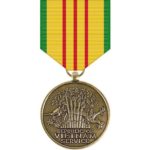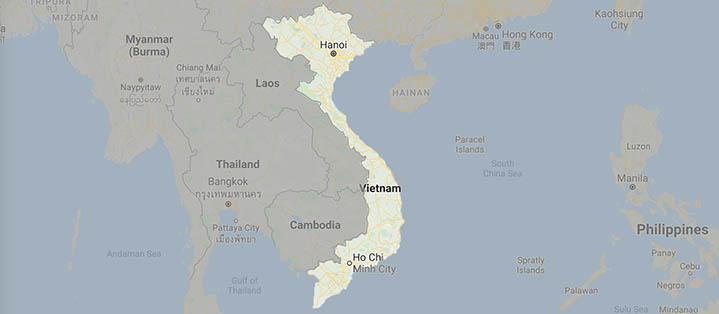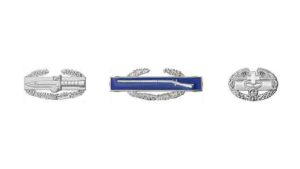Vietnam Service Medal
 On the 8th of July, 1965, the Vietnam Service Medal was established by Executive Order 11231. An executive order being a means of issuing federal directives in the United States, it was used by President Lyndon B. Johnson to create the medal. The Executive Order was later amended by Executive Order 13286 on February 2, 2003 under President George W. Bush.
On the 8th of July, 1965, the Vietnam Service Medal was established by Executive Order 11231. An executive order being a means of issuing federal directives in the United States, it was used by President Lyndon B. Johnson to create the medal. The Executive Order was later amended by Executive Order 13286 on February 2, 2003 under President George W. Bush.
The general purpose of the award was to acknowledge the contributions of soldiers (and other service members) serving in the Vietnam War. The policies regarding award of the Vietnam Service Medal along with the other awards granted to United States Army soldiers are prescribed in Army Regulation 600-8-22 while the wear and appearance are governed by Army Regulation 670-1.


Executive Order
Executive Order 11231 establishing the Vietnam Service Medal
Section 1
There is hereby established the Vietnam Service Medal with suitable appurtenances. Except as limited in section 2 of this order, and under uniform regulations to be prescribed by the Secretaries of the military departments and approved by the Secretary of Defense, or regulations to be prescribed by the Secretary of Transportation with respect to the Coast Guard when it is not operating as a service in the Navy, the Vietnam Service Medal shall be awarded to members of the armed forces who serve in Vietnam or contiguous waters or air space, as defined by such regulations, after July 3, 1965, and before a terminal date to be prescribed by the Secretary of Defense.
Section 2
Notwithstanding section 3 of the Executive Order No. 10977 of December 4, 1961, establishing the Armed Forces Expeditionary Medal, any member who qualified for that medal by reason of service in Vietnam between July 1, 1958, and July 4, 1965, shall remain qualified for that medal. Upon application, any such member may be awarded the Vietnam Service Medal in lieu of the Armed Forces Expeditionary Medal, but no person may be awarded both medals by reason of service in Vietnam and no person shall be entitled to more than one award of the Vietnam Service Medal.
Section 3
The Vietnam Service Medal may be awarded posthumously.
Requirements
The Vietnam Service Medal is awarded to all service members (of all ranks) of the Armed Forces of the United States serving in Vietnam, its contiguous waters, and airspace. The time period that is to be considered for this service is from the 3rd of July 1965 through the 28th of March 1973. Additionally, those service members of the Armed Forces of the United States who served in the countries of Thailand, Laos, or Cambodia, or the airspace over them during the same period are also eligible provided they served in direct support of operations in Vietnam.
Geography

In terms of geographical limits for award eligibility, Vietnam and its contiguous waters includes Vietnam and the water adjacent to it from a point on the East Coast of Vietnam where Vietnam meets China southeastward to 21 degrees north latitude, 108 degrees, 15 minutes longitude;
- then southward to 18 degrees, north latitude, 108 degrees, 15 minutes east longitude;
- then southeastward to 17 degrees, 30 minutes north latitude, 111 degrees east longitude;
- then southward to 11 degrees north latitude, 111 degrees east longitude;
- then southwestward to 7 degrees north latitude, 105 degrees east longitude;
- then westward to 7 degrees north latitude, 103 degrees east longitude;
- then northward to 9 degrees, 30 minutes north latitude, 103 degrees east longitude;
- then northeastward to 10 degrees, 15 minutes north latitude, 104 degrees, 27 minutes east longitude;
- then northward to a point on the West Coast of Vietnam where Vietnam meets Cambodia.

Qualifications
To qualify for award of the Vietnam Service Medal, an individual must meet one of the following qualifications:
- Be attached to or regularly serve for 1 or more days with an organization participating in or directly supporting military operations.
- Be attached to or regularly serve for 1 or more days aboard a U.S. naval vessel directly supporting military operations.
- Participate as a crewmember in one or more aerial flights into airspace above Vietnam and contiguous waters directly supporting military operations.
- Serve on Temporary Duty Assignment for 30 consecutive days or 60 nonconsecutive days in Vietnam or contiguous areas, except that time limit may be waived for personnel participating in actual combat operations.
Additional Considerations
- No person will be entitled to more than one award of the Vietnam Service Medal.
- Individuals qualified for the Armed Forces Expeditionary Medal for reason of service in Vietnam between 1 July, 1958 and 3 July, 1965 will remain qualified for that medal. Upon request (unit personnel officer) any such individual may be awarded the Vietnam Service Medal instead of the Armed Forces Expeditionary Medal. In such instances, the Armed Forces Expeditionary Medal will be deleted from the list of authorized medals in personnel records. No person will be entitled to both awards for Vietnam service.
- Servicemembers who earned the AFEM for Operation FREQUENT WIND between 29 and 30 April 1975, may elect to receive the VSM instead of the AFEM. No service member may be issued both medals for service in Vietnam.
- The Vietnam Service Medal may be awarded posthumously.
- The boundaries of the Vietnam combat zone for campaign participation credit are as defined in paragraph 2–14 on page 34 of AR 600-8-22.
Appurtenances
One bronze service star is authorized for each campaign under the following conditions:
Was assigned or attached to and present for duty with a unit during the period in which it participated in combat.
Was under orders in the combat zone and in addition meets any of the following requirements:
- Awarded a combat decoration.
- Furnished a certificate by a CG of a corps, higher unit, or independent force that Soldier participated in combat.
- Served at a normal post of duty (as contrasted to occupying the status of an inspector, observer, or visitor).
- Aboard a vessel other than in a passenger status and furnished a certificate by the homeport commander of the vessel that he or she served in the combat zone.
Was an evadee or escapee in the combat zone or recovered from a POW status in the combat zone during the time limitations of the campaign. POWs will not be accorded credit for the time spent in confinement or while otherwise in restraint under enemy control.
Table of Vietnam Campaigns
| Campaign | Dates | Role |
|---|---|---|
| Advisory | 15 March, 1962 to 7 March, 1965 | VIETNAM ADVISORY, 1962–1965 |
| Defense | 8 March, 1965 to 24 December, 1965 | VIETNAM DEFENSE, 1965 |
| Counteroffensive | 25 December, 1965 to 30 June, 1966 | VIETNAM COUNTEROFFENSIVE, 1965–1966 |
| Counteroffensive Phase II | 1 July, 1966 to 31 May, 1967 | VIETNAM COUNTEROFFENSIVE, PHASE II, 1966–19672 |
| Counteroffensive-Phase III | 1 June, 1967 to 29 January, 1968 | VIETNAM COUNTEROFFENSIVE, PHASE III, 1967–1968 |
| Tet Counteroffensive | 30 January, 1968 to 1 April, 1968 | TET COUNTEROFFENSIVE, 1968 |
| Counteroffensive- Phase IV | 2 April, 1968 to 30 June, 1968 | VIETNAM COUNTEROFFENSIVE, PHASE IV, 1968 |
| Counteroffensive Phase V | 1 July, 1968 to 1 November, 1968 | VIETNAM COUNTEROFFENSIVE, PHASE V, 1968 |
| Counteroffensive Phase VI | 2 November, 1968 to 22 February, 1969 | VIETNAM COUNTEROFFENSIVE, PHASE VI, 1968–1969 |
| Tet 69 Counteroffensive | 23 February, 1969 to 8 June, 1969 | TET 69 COUNTEROFFENSIVE, 1969 |
| Summer/Fall 1969 | 9 June, 1969 to 31 October, 1969 | VIETNAM SUMMER – FALL 1969 |
| Winter/Spring 1970 | 1 November, 1969 to 30 April, 1970 | VIETNAM WINTER – SPRING 1970 |
| Sanctuary Counteroffensive | 1 May, 1970 to 30 June, 1970 | SANCTUARY COUNTEROFFENSIVE, 1970 |
| Counteroffensive Phase VII | 1 July, 1970 to 30 June, 1971 | VIETNAM COUNTEROFFENSIVE, PHASE VII, 1970–1971 |
| Consolidation I | 1 July, 1971 to 30 November, 1971 | CONSOLIDATION I, 1971 |
| Consolidation II | 1 December, 1971 to 29 March, 1972 | CONSOLIDATION II, 1971–1972 |
| Cease-Fire | 30 March, 1972 to 28 January, 1973 | VIETNAM CEASE – FIRE, 1972–1973 |
Appearance
Medal
The Vietnam Service Medal is a circular medal made of bronze. It has a diameter of 1 ¼ inches. On the face of the medal, there is an oriental dragon behind a grove of bamboo trees. The bamboo trees were adapted from the flag of the President of Vietnam and the half-concealed dragon represents the subversive nature of the conflict.
In Vietnamese mythology, the Vietnamese people descended from a dragon and a fairy. The dragon represents the emperor, the prosperity, and the power of the nation.The bamboo, in Vietnamese culture, symbolizes vitality that can resist the strong winds and storms The words “REPUBLIC OF VIETNAM SERVICE” are inscribed below the image.
The back side of the medal features an image of a crossbow surmounted by a torch. The crossbow is the ancient weapon of Vietnam. The torch of the Statue of Liberty is a symbol of the United States devotion to liberty and freedom. The arched inscription “UNITED STATES OF AMERICA” crosses the bottom of it.
Suspension
The colors of the suspension ribbon for the Vietnam Service Medal are yellow, red, and green. The yellow ribbon with three vertical red stripes suggests the color of the flag of the Republic of Vietnam. A green border on each side alludes to the jungle of Vietnam. The suspension ribbon is attached to the suspension ring which is of a thick wire and is used to attach the medal to the ribbon.
Order of Precedence
According to Army Regulation 600-8-22, the Vietnam Service Medal is classified under U.S. service (campaign) medals and service and training ribbons. AR 670-1 contains the doctrinal language in regards to the proper wear of these awards. Department of the Army Pamphlet 670-1 supports Army Regulation 670-1 by providing specific examples and fleshes out the regulation. It provides clarification, illustrations and specific examples to guide in its use.
The order of preference in the category of U.S. Service (campaign) medals and service training ribbons is as follows;
- Prisoner of War Medal
- Good Conduct Medal
- Good Conduct Medals from the other Services follow the Army Good Conduct Medal in order of precedence. The Army Reserve Component Achievement Medal and equivalents awarded by other Service Reserve Components follow the Army Good Conduct Medal and Good Conduct Medals from the other U.S. Services, in order of precedence.
- American Defense Service Medal
- Women’s Army Corps Service Medal
- American Campaign Medal
- Asiatic-Pacific Campaign Medal
- European-African-Middle Eastern Campaign Medal
- World War II Victory Medal
- Army of Occupation Medal
- Medal for Humane Action
- National Defense Service Medal
- Korean Service Medal
- Antarctica Service Medal
- Armed Forces Expeditionary Medal
- Vietnam Service Medal
- Southwest Asia Service Medal
- Kosovo Campaign Medal
- Afghanistan Campaign Medal
- Iraq Campaign Medal
- Inherent Resolve Campaign Medal
- Global War on Terrorism-Expeditionary Medal
- Global War on Terrorism-Service Medal
- Korean Defense Service Medal
- Armed Forces Service Medal
- Humanitarian Service Medal
- Military Outstanding Volunteer Service Medal
- Army Sea Duty Ribbon
- Armed Forces Reserve Medal
- NCO Professional Development Ribbon
- Army Service Ribbon
- Overseas Service Ribbon
- Army Reserve Components Overseas Training Ribbon
- Coast Guard Special Operations Service Ribbon
- Air Force Combat Readiness Medal
- Navy Sea Service Deployment Ribbon


